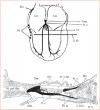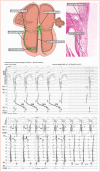Mahaim Revisited
- PMID: 35990105
- PMCID: PMC9376831
- DOI: 10.15420/aer.2022.12
Mahaim Revisited
Abstract
The name Ivan Mahaim is well-known to electrophysiologists. However, alternative anatomical substrates can produce the abnormal rhythms initially interpreted on the basis of the pathways he first described. These facts have prompted suggestions that Mahaim should be deprived of his eponym. It is agreed that specificity is required when describing the pathways that produce the disordered cardiac conduction, and that the identified pathways should now be described in an attitudinally appropriate fashion. The authors remain to be convinced that understanding will be enhanced simply by discarding the term 'Mahaim physiology' from the lexicon. It is fascinating to look back at the history of accessory atrioventricular junctional conduction pathways outside the normal accessory atrioventricular conduction system, and their possible role in rhythm disturbances. It took both the anatomist and the clinical arrhythmologist quite some time to understand the complex anatomical architecture and the ensuing electrophysiological properties. Over the years, the name Mahaim was often mentioned in those discussions, although these pathways were not the ones that produced the eponym. The reason for this review, therefore, is to present relevant information about the person and what followed thereafter.
Keywords: Ventricular pre-excitation; atriofascicular tract; atrioventricular node; fasciculoventricular pathways; nodoventricular pathways.
Copyright © 2022, Radcliffe Cardiology.
Conflict of interest statement
Disclosure: RHA is on the Arrhythmia & Electrophysiology Review editorial board; this did not influence peer review. All other authors have no conflicts of interest to declare.
Figures
References
-
- Correa FS, Lokhandwala Y, Filho FC et al. Part II—Clinical presentation, electrophysiologic characteristics, and when and how to ablate atriofascicular pathways and long and short decrementally conducting accessory pathways. J Cardiovasc Electrophysiol. 2019;30:3079–96. doi: 10.1111/jce14203. - DOI - PubMed
-
- Soares Correa F, Lokhandwala Y, Sánchez-Quintana D et al. Unusual variants of pre-excitation: from anatomy to ablation: part III – clinical presentation, electrophysiologic characteristics, when and how to ablate nodoventricular, nodofascicular, fasciculoventricular pathways, along with considerations of permanent junctional reciprocating tachycardia. J Cardiovasc Electrophysiol. 2019;30:3097–115. doi: 10.1111/jce.14247. - DOI - PubMed
-
- Wellens HJJ. Normal PR interval-small delta wave-normal QRS complex. In: Wellens HJJ. Electrical Stimulation of the Heart in the Study and Treatment of Tachycardias. Baltimore: University Park Press. 1971. pp. 97–109.
Publication types
LinkOut - more resources
Full Text Sources






